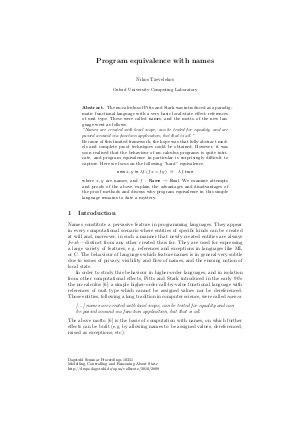Program Equivalence with Names
Author Nikos Tzevelekos
-
Part of:
Volume:
Dagstuhl Seminar Proceedings, Volume 10351
Part of: Series: Dagstuhl Seminar Proceedings (DagSemProc) - License:
 Creative Commons Attribution 4.0 International license
Creative Commons Attribution 4.0 International license
- Publication Date: 2010-11-04
File

PDF
DagSemProc.10351.5.pdf
- Filesize: 193 kB
- 18 pages
Document Identifiers
Subject Classification
Keywords
- Nu-calculus
- Local State
- Logical Relations
- Game Semantics
- Environmental Bisimulations
Metrics
- Access Statistics
-
Total Accesses (updated on a weekly basis)
0PDF Downloads0Metadata Views
Abstract
The nu-calculus of Pitts and Stark was introduced as a paradigmatic functional language with a very basic local-state effect: references of unit type. These were called names, and the motto of the new language went as follows: "Names are created with local scope, can be tested for equality, and are passed around via function application, but that is all." Because of this limited framework, the hope was that fully abstract models and complete proof techniques could be obtained. However, it was soon realised that the behaviour of nu-calculus programs is quite intricate, and program equivalence in particular is surprisingly difficult to capture. Here we shall focus on the following "hard" equivalence. new x,y in f. (fx=fy) == f. true We shall examine attempts and proofs of the above, explain the advantages and disadvantages of the proof methods and discuss why program equivalence in this simple language remains to date a mystery.
Cite As Get BibTex
Nikos Tzevelekos. Program Equivalence with Names. In Modelling, Controlling and Reasoning About State. Dagstuhl Seminar Proceedings, Volume 10351, pp. 1-18, Schloss Dagstuhl – Leibniz-Zentrum für Informatik (2010)
https://doi.org/10.4230/DagSemProc.10351.5
BibTex
@InProceedings{tzevelekos:DagSemProc.10351.5,
author = {Tzevelekos, Nikos},
title = {{Program Equivalence with Names}},
booktitle = {Modelling, Controlling and Reasoning About State},
pages = {1--18},
series = {Dagstuhl Seminar Proceedings (DagSemProc)},
ISSN = {1862-4405},
year = {2010},
volume = {10351},
editor = {Amal Ahmed and Nick Benton and Lars Birkedal and Martin Hofmann},
publisher = {Schloss Dagstuhl -- Leibniz-Zentrum f{\"u}r Informatik},
address = {Dagstuhl, Germany},
URL = {https://drops.dagstuhl.de/entities/document/10.4230/DagSemProc.10351.5},
URN = {urn:nbn:de:0030-drops-28092},
doi = {10.4230/DagSemProc.10351.5},
annote = {Keywords: Nu-calculus, Local State, Logical Relations, Game Semantics, Environmental Bisimulations}
}
